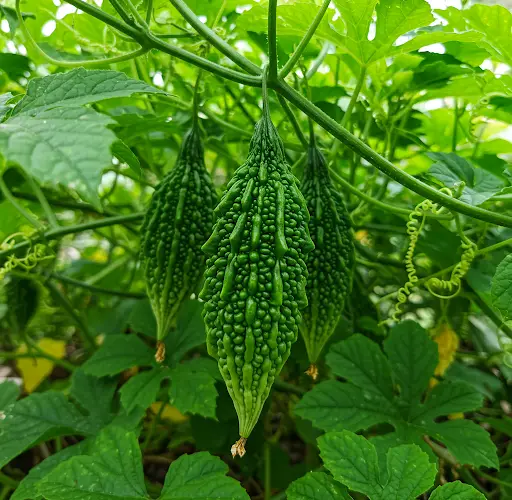How to Grow Bitter Melon from Seeds Easily for Beginners
Bitter melon (Momordica charantia), also known as bitter gourd, is a tropical vine widely cultivated for its edible, highly nutritious, and medicinally valuable fruit. If you’re a beginner gardener, growing bitter melon from seeds can be a rewarding experience. This guide will walk you through the step-by-step process of successfully growing bitter melon with ease.
Understanding Bitter Melon
Bitter melon is a warm-season crop that thrives in tropical and subtropical climates. It belongs to the Cucurbitaceae family, which includes cucumbers, pumpkins, and squash. The plant produces elongated, warty fruits that have a distinct bitter taste and numerous health benefits, including improving digestion, reducing blood sugar levels, and boosting immunity.
Step-by-Step Guide to Growing Bitter Melon from Seeds
1. Choosing the Right Seeds
Selecting high-quality seeds is crucial for a successful harvest. You can obtain seeds from:
- A gardening store
- Online seed suppliers
- Mature bitter melon fruits (simply extract the seeds, wash them, and dry them before storing)
To improve germination, choose fresh seeds with a firm outer shell.
2. Pre-Treating the Seeds
Bitter melon seeds have a hard outer coat that can slow down germination. To enhance sprouting, you can:
- Soak the seeds in warm water for 24 hours.
- Scarify the seeds by gently rubbing them with sandpaper or nicking the outer shell with a knife.
- Wrap the seeds in a damp paper towel, place them in a plastic bag, and keep them in a warm location until they start sprouting.
3. Choosing the Right Location
Bitter melon thrives in warm temperatures and full sunlight. Select a planting site that receives at least 6-8 hours of direct sunlight daily. If you live in a cooler climate, consider growing bitter melon in a greenhouse or containers that can be moved indoors when necessary.
4. Preparing the Soil
Bitter melon prefers well-draining, nutrient-rich soil with a slightly acidic to neutral pH (6.0–6.8). Follow these steps to prepare the soil:
- Loosen the soil to a depth of 12 inches.
- Add organic matter such as compost, well-rotted manure, or organic fertilizer to enrich the soil.
- Ensure proper drainage by avoiding heavy clay soil that retains excess moisture.
5. Planting the Seeds
After soil preparation, sow the seeds following these guidelines:
- Plant seeds about ½ to 1 inch deep.
- Space seeds 12–18 inches apart in rows or hills.
- Water the soil gently after planting to keep it moist but not waterlogged.
- Cover the planting area with mulch to retain moisture and suppress weeds.
6. Watering and Care
- Watering: Bitter melon requires consistent moisture, especially during germination and flowering. Water the plant 2-3 times a week, ensuring that the soil remains slightly moist but not soggy.
- Mulching: Apply organic mulch like straw or dried leaves to retain soil moisture and regulate temperature.
- Fertilization: Apply a balanced organic fertilizer every 2-3 weeks to promote vigorous growth.
7. Providing Support
Bitter melon is a vining plant that needs a trellis, fence, or stake for support. Training the vines upward will:
- Improve air circulation, reducing the risk of fungal diseases.
- Make harvesting easier.
- Prevent the fruits from rotting by keeping them off the ground.
8. Pest and Disease Management
Common pests that attack bitter melon include aphids, spider mites, and fruit flies. Prevent infestations by:
- Regularly inspecting plants for pests.
- Spraying neem oil or organic insecticides.
- Encouraging beneficial insects like ladybugs and lacewings.
To prevent fungal diseases like powdery mildew, avoid overhead watering and ensure good air circulation around plants.
9. Flowering and Pollination
Bitter melon produces both male and female flowers. Pollination is essential for fruit development. If natural pollinators are scarce, hand-pollinate by transferring pollen from male to female flowers using a small brush or cotton swab.
10. Harvesting Bitter Melon
Bitter melons are usually ready to harvest 60-70 days after planting. Here’s how to know when they are ripe:
- Pick the fruit when it is still green and firm (about 4-6 inches long, depending on the variety).
- Avoid overripe fruits, which turn yellow and become overly bitter.
- Use a sharp knife or scissors to cut the fruit off the vine.
11. Saving Seeds for Future Planting
To save seeds for the next season:
- Allow some fruits to fully ripen until they turn yellow and split open.
- Remove the seeds, wash off the pulp, and dry them completely.
- Store dried seeds in an airtight container in a cool, dry place.
Conclusion
Growing bitter melon from seeds is simple and rewarding, even for beginners. By following the steps outlined above—selecting quality seeds, preparing the soil, providing proper care, and managing pests—you can enjoy a bountiful harvest of fresh, homegrown bitter melons. With patience and consistent care, you’ll be able to cultivate this nutritious vegetable successfully in your own garden.
Happy gardening!



